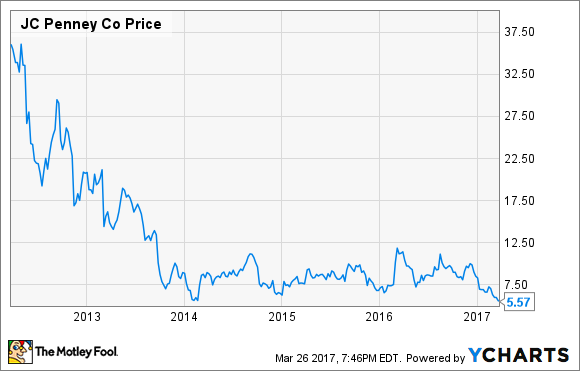During 2012 and 2013, sales and profit plunged at J.C. Penney (JCP +0.00%) as customers rebelled against an ill-advised attempt to cut back on coupons and discounts. Not surprisingly, J.C. Penney shares plummeted as well, falling to a multi-decade low around $7 in late 2013.
Since then, J.C. Penney's new management team has executed a remarkable turnaround, putting the company back in the black. However, the stock has moved even lower, closing at $5.57 last week: down 33% since the beginning of 2017.
J.C. Penney Stock Performance, data by YCharts.
This raises an interesting question: Were investors crazy to pay as much as $20 for J.C. Penney stock in 2013 when the company was hemorrhaging cash? Or are investors being crazy now by valuing J.C. Penney at even less than the $7 they thought it was worth during the very worst days in late 2013?
J.C. Penney had a brush with death
There's no doubt that J.C. Penney was in big trouble a few years ago. Comparable store sales plunged 25.2% in 2012, causing the company to incur an adjusted operating loss of $939 million. The comp sales decline slowed to 7.4% in fiscal year 2013, but J.C. Penney's adjusted operating loss widened to $1.2 billion.
Most ominously, J.C. Penney posted negative free cash flow of more than $2.7 billion in 2013. It had to mortgage most of its real estate just to raise enough cash to make it through the year. By mid-2013, J.C. Penney seemed to be on the road to bankruptcy.

J.C. Penney was burning cash at an unsustainable rate four years ago. Image source: J.C. Penney.
J.C. Penney's deep losses were particularly worrisome because unlike rival Sears Holdings (SHLD +0.00%), it didn't have a vast portfolio of real estate to sell off to fund operating losses. If free cash flow had remained deep in negative territory beyond 2013, it's unlikely that J.C. Penney would have survived.
Given this dire situation, it's surprising that J.C. Penney stock didn't fall further in 2013. As late as Q3 2013, sales were still declining and the company was losing money at a rate that would have forced it into bankruptcy relatively quickly.
A miraculous recovery
In the past three years, J.C. Penney has made a stunning comeback, culminating in it earning an annual profit for the first time in five years during 2016. For most of 2014 and 2015, comp sales rose at a 4% to 5% annual rate, driving huge margin improvements.
Even more importantly, J.C. Penney bounced back from its 2013 free cash flow of -$2.7 billion to generate positive free cash flow of $57 million in 2014. It improved on that figure with free cash flow of $131 million in 2015.
This free cash flow generation, along with a handful of asset sales, has allowed J.C. Penney to start reducing its debt. Credit rating agencies have taken notice, upgrading the company's debt rating multiple times.
A setback
To be fair, J.C. Penney did hit a speed bump in its recovery last year. Comp sales were flat in 2016, and while the company earned an adjusted profit for the year, free cash flow plunged to just $3 million.
However, on the bright side, the weak retail climate is helping to push Sears Holdings to the brink of bankruptcy. Sears doesn't have many assets left that are owned free and clear, while its losses continue to pile up. The company has been shedding billions of dollars of revenue on an annual basis, yet it still generated sales of more than $22 billion last year. Thus, there will be a lot more revenue up for grabs if Sears ultimately folds in the next few years.

J.C. Penney will benefit if Sears folds in the next few years. Image source: Sears.
J.C. Penney has been carefully positioning itself to profit from Sears' steady decline. Most notably, it opened appliance sections in about 500 stores last year, and will add appliances to even more stores in 2017.
Of course, J.C. Penney isn't just hoping to be bailed out by Sears collapsing. The company continues to find ways to cut costs and it is experimenting with various attractions to drive more traffic to its stores. J.C. Penney will also close 138 underperforming locations in the next few months to improve the quality of its store base.
Investors shouldn't panic
J.C. Penney's market cap has fallen to a pitiful $1.7 billion. That's less than double Sears Holdings' market cap of roughly $900 million, even though Sears has been bleeding cash at a rate of about $1.5 billion per year, whereas J.C. Penney is at worst breaking even.
J.C. Penney vs. Sears Holdings Market Cap, data by YCharts.
Furthermore, J.C. Penney expects free cash flow to rebound to a range of $300 million to $400 million this year, due to cost reductions and working capital improvements, as well as some asset sales. It will use this cash to further reduce its debt, driving permanent interest expense savings.
J.C. Penney is steadily solidifying its financial position, despite the tough retail climate. Even if mall traffic trends remain sluggish, the company is poised to benefit as weaker rivals like Sears are driven out of business. J.C. Penney shares may have been overvalued four years ago when the company was still racking up huge losses, but now investors appear to be underestimating its long-term prospects.








